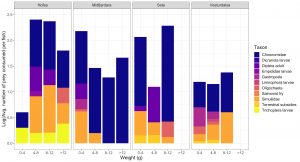The prey availability and diet of juvenile Atlantic salmon (Salmo salar L.) in low-productivity rivers in northern Europe
The prey availability and diet of juvenile Atlantic salmon (Salmo salar L.) in low-productivity rivers in northern Europe
accepted for publication in the Journal of Fish Biology. http://doi.org/10.1111/jfb.15757
Authors:
Sum Yi Lai1,2, Arnar Pálsson2, Guðni Guðbergsson1, Ingi Rúnar Jónsson1, Jón S. Ólafsson1, Hlynur Bárðarson1
1. Marine and Freshwater Research Institute, Hafnarfjördur, Iceland
2. University of Iceland, Reykjavík, Iceland
Corresponding author: Name: Sum Yi Lai Address: Marine and Freshwater Research Institute, Fornubúdir 5, 220 Hafnarfjördur, Iceland,
Email: sammi.lai@hafogvatn.is
Abstract:
The availability of resources varies across a species distributional range, and a low productivity area can make a species more vulnerable. We investigated the invertebrate composition and prey choice of juvenile Atlantic salmon (Salmo salar L.) in low productivity rivers at Northeast Iceland, which is one of the species´ most northerly distributions. By sampling benthic and drift invertebrate populations, we found that prey availability was similar within and between rivers. Gut content samples showed that the main prey choice for juvenile S. salar was the Chironomidae. The type of food items consumed varied across different weight groups of S. salar, with smaller juveniles having more diverse diet. S. salar did not have a selection preference for chironomids, which indicate that they were eating the highly available prey in their environment, rather than hunting high biomass items such as terrestrial invertebrates and large Dipterans. Estimates of dietary niche showed that S. salar in these low-productivity rivers relied on consuming what was most readily available, the chironomids, and that they must share resources with other salmonid species. This may be due to the low diversity of freshwater invertebrates (fewer prey options), whereas S. salar in nutrient-rich rivers could rely more on terrestrial invertebrates as an additional subsidy in their diet. In conclusion, with limited prey choices, juvenile S. salar in nutrient-poor rivers, especially in a biogeographically isolated region with low species diversity, may increase in vulnerability and decrease in adaptability to environmental change. Management methods that increase benthic prey abundance and diversity are recommended for conserving S. salar population in a nutrient-poor river

Log10 average number of prey items found in stomachs of juvenile Atlantic salmon (Salmo salar) was differed significantly across rivers (p<0.001) and by weight ranges (p<0.001).
The number of prey items consumed increased with weight (p<0.05). Log10 abundance also varies between taxonomic groups for all rivers (p<0.001) with abundances of Chironomidae higher in comparison.